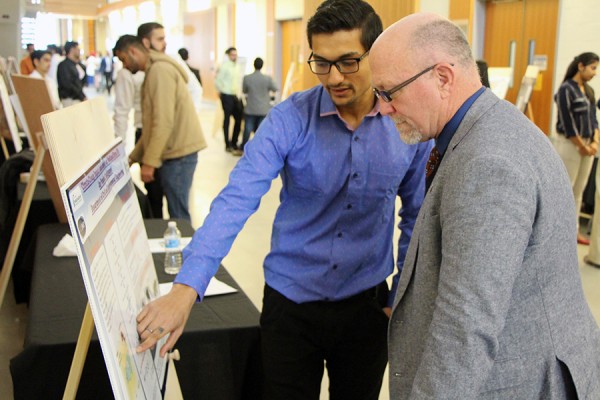 First-year civil engineering student Jay Panchal discusses a project with acting director Mark Burrows of the International Joint Commission during World Water Day presentations Thursday in the Centre for Engineering Innovation.
First-year civil engineering student Jay Panchal discusses a project with acting director Mark Burrows of the International Joint Commission during World Water Day presentations Thursday in the Centre for Engineering Innovation.
Swollen by rain and melting snow, the Thames River burst its banks in February, inundating southwestern Ontario with its worst floods in 40 years.
The effects of such a catastrophe can be mitigated, says Monika Saha, a master’s candidate in civil engineering, and one of more than 20 students who presented projects in the Centre for Engineering Innovation on Thursday, March 22, in celebration of World Water Day.
Saha is working to create models of the lower Thames River that can predict floods in Chatham-Kent.
“We’ll basically capture the flow. With our hydrologic and hydraulic models getting the input level, it will give you the output to predict which areas will be inundated,” she said. “You will be able to take precautions.”
The results of her project will need to be mapped to elevation data to develop actionable results for authorities.
“The object is to give people time to take adequate measures to protect themselves and their property,” said Saha.
Relating the academic work to real-world problems is a key consideration for students in his course “Climate change adaptation for water engineers,” said professor Tirupati Bolisetti.
“The projects on display today cover a very broad range of topics, both in scientific content and geographical reach,” he said. “Some deal with watersheds in the Great Lakes basin, and others in India. We want them to apply the technical skills to contemporary issues.”
Mark Burrows, acting director of the International Joint Commission, addressed the students on the subject of the need for research into water quality of the Great Lakes. He praised the coursework for engaging them in current questions involving local rivers.
“It’s refreshing to see the youthful enthusiasm here,” Burrows said as he toured poster presentations in the CEI lobby. “I hope they all consider careers in government service.”
